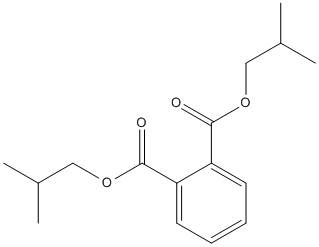Diisobutyl-phthalate
General
Type : Aryl ester || Phthalate
Chemical_Nomenclature : bis(2-methylpropyl) benzene-1,2-dicarboxylate
Canonical SMILES : CC(C)COC(=O)C1=CC=CC=C1C(=O)OCC(C)C
InChI : InChI=1S\/C16H22O4\/c1-11(2)9-19-15(17)13-7-5-6-8-14(13)16(18)20-10-12(3)4\/h5-8,11-12H,9-10H2,1-4H3
InChIKey : MGWAVDBGNNKXQV-UHFFFAOYSA-N
Other name(s) : Diisobutyl phthalate, DIBP, Palatinol IC, Isobutyl phthalate, Phthalic Acid Diisobutyl Ester, CHEBI:79053, SCHEMBL42787, CHEMBL1370662, ZINC388318

Target
Families : HNLyase_Bact, Bacterial_esterase
References (3)
| Title : Characterization and genomic analysis of an efficient dibutyl phthalate degrading bacterium Microbacterium sp. USTB-Y - Zhao_2021_World.J.Microbiol.Biotechnol_37_212 |
| Author(s) : Zhao Z , Liu C , Xu Q , Ahmad S , Zhang H , Pang Y , Aikemu A , Liu Y , Yan H |
| Ref : World J Microbiol Biotechnol , 37 :212 , 2021 |
| Abstract : Zhao_2021_World.J.Microbiol.Biotechnol_37_212 |
| ESTHER : Zhao_2021_World.J.Microbiol.Biotechnol_37_212 |
| PubMedSearch : Zhao_2021_World.J.Microbiol.Biotechnol_37_212 |
| PubMedID: 34738191 |
| Gene_locus related to this paper: 9mico-DpeH , 9mico-MpeH |
| Title : Degradation of dibutyl phthalate (DBP) by a bacterial consortium and characterization of two novel esterases capable of hydrolyzing PAEs sequentially - Lu_2020_Ecotoxicol.Environ.Saf_195_110517 |
| Author(s) : Lu M , Jiang W , Gao Q , Zhang M , Hong Q |
| Ref : Ecotoxicology & Environmental Safety , 195 :110517 , 2020 |
| Abstract : Lu_2020_Ecotoxicol.Environ.Saf_195_110517 |
| ESTHER : Lu_2020_Ecotoxicol.Environ.Saf_195_110517 |
| PubMedSearch : Lu_2020_Ecotoxicol.Environ.Saf_195_110517 |
| PubMedID: 32220793 |
| Gene_locus related to this paper: 9mico-DpeH , 9mico-MpeH |
| Title : Assessment of phthalate ester residues and distribution patterns in Baijiu raw materials and Baijiu - Dong_2019_Food.Chem_283_508 |
| Author(s) : Dong W , Guo R , Sun X , Li H , Zhao M , Zheng F , Sun J , Huang M , Wu J |
| Ref : Food Chem , 283 :508 , 2019 |
| Abstract : Dong_2019_Food.Chem_283_508 |
| ESTHER : Dong_2019_Food.Chem_283_508 |
| PubMedSearch : Dong_2019_Food.Chem_283_508 |
| PubMedID: 30722905 |